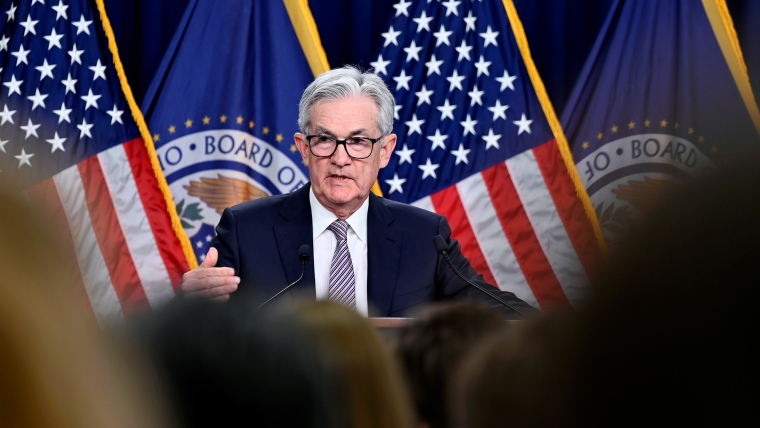
As expected, the Fed kept policy on hold and there were only minor tweaks to the release. There was a nod to growth slowing, noting economic activity “moderated in the first half of the year”, previously characterised as expanding at a solid pace. “Uncertainty about the economic outlook remains elevated”, the statement removing the reference to uncertainty as having diminished. In a repeat, “labour market conditions remain solid” and “inflation remains somewhat elevated”.
The defining feature of the meeting was two dissents in favour of a rate cut by Trump-appointees Waller and Bowman. While this was widely anticipated, it is the first occasion of more than one Governor dissenting since 1993 (dissents by regional Fed Presidents are more common). This plays to fears that the Fed has become increasingly politicised and is losing its independence.
While there was some risk of Chair Powell opening the door to a September rate cut, in his press conference he played with a straight bat, saying “we have made no decisions about September”. He still characterised policy as modestly restrictive and noted downside risk to the labour market. But clearly, any decision to cut rates will be data dependent, with two employment reports and CPI reports ahead of that meeting.
Ahead of the Fed meeting, the USD was broadly stronger and US Treasury yields were modestly higher in response to data showing slightly stronger than expected GDP growth and core PCE deflator (see below). With no clear indication that the Fed will be cutting as soon as September, the market slightly extended those moves during Powell’s press conference.
Powell is still speaking as we go to print and the market is a little jumpy, but the USD DXY index is up a solid 0.7% for the day and the NZD has slipped just below 0.59. The NZD and AUD have been two of the weakest majors overnight, both down over 1%, so the NZD is flat to slightly weaker on the crosses, apart from a small lift in NZD/AUD to 0.9165, supported after soft Australian CPI data.
US Treasury yields are up 6-7bps for 2 and 10-year rates, seeing the latter at 4.38%, at its high for the day. US equities are up slightly. The market prices 38bps of Fed cuts by year-end, compared to 46bps priced at yesterday’s close.
In its quarterly statement on debt issuance, the US Treasury said it will rely more on short-dated securities to fund the federal deficit “at least until 2026” and anticipates keeping the size of its note and bond auctions unchanged “for at least the next several quarter”. The business-as-usual statement was well anticipated by the market, and the strategy will see short-term Treasury Bills rise as a percentage of outstanding debt.
US GDP was slightly stronger than expected, rising at an annualised 3.0% in Q2 following the 0.5% fall in Q2. The surge in imports in Q1, followed by the plunge in Q2 as businesses brought forward imports ahead of higher tariffs explains the volatility. The average 1.25% growth over the first half of the year is a better measure of economic performance, much weaker compared to average growth of 2.5% through 2024. Personal consumption grew 1.4% annualised in Q1 following 0.5% in Q1, portraying sluggish consumer spending over the first half. Fixed investment rose just 0.4% annualised, with a slump in residential and non-residential building offset by strong software and equipment investment linked to the boom in AI.
The core PCE deflator rose an annualised 2.5% in Q2, higher than the 2.3% expected. If there were no data revisions, this would imply a jump of 0.5% m/m in June, compared to expectations of 0.3% m/m, in data to be released Friday, but April and/or May were probably revised higher. Still, higher core inflation doesn’t help the case for easier monetary policy unless the labour market significantly deteriorates.
ADP private payrolls, rose 104k in July, stronger than the 75k expected, but the series has been a poor predictor of non-farm payrolls, which is the key employment figure released on Friday. A 0.8% drop in pending home sales continued the theme of weak housing market activity.
Euro area GDP rose 0.1% in Q2, a touch higher than the flat result expected, with small contractions in Germany and Italy, offset by growth for France and Spain. The tepid lift in activity follows the solid 0.6% gain in Q1. Still, on a day where US GDP growth is running relatively much stronger, it highlights that some fragility for the end of US growth exceptionalism narrative.
The Bank of Canada left its policy rate unchanged at 2.75% for a third consecutive meeting. The Bank maintained an easing bias, noting “If a weakening economy puts further downward pressure on inflation and the upward price pressures from the trade disruptions are contained, there may be a need for a reduction in the policy interest rate”. The Bank stuck with producing scenarios, rather than point forecasts, given the uncertainty about US tariff policy. Governor Macklem said "The unusual degree of uncertainty does mean we have to put more weight on the risks, look over a shorter horizon than usual, and be ready to respond to new information". Canadian rates showed little net movement for the day, while the moderately weaker CAD reflected broad USD strength.
President Trump said he would impose a 25% tariff on imports from India from 1-August, plus a penalty for buying Russian military equipment and energy. He added that India has tariffs that are “among the highest in the world, and they have the most strenuous and obnoxious non-monetary trade barriers of any country”. For other countries, Trump said the 1-August deadline stands strong and will not be extended, meaning higher tariffs will kick in for those countries which haven’t secured deals, such as South Korea, Taiwan, Canada and Mexico. We still await the higher tariff NZ and Australia will face, which is likely to be either 15% or 20%. Trump signed an executive order for a 50% tariff for Brazil, effective in seven days, albeit with a long list of exemptions.
Australian Q2 CPI data were on the softer side of expectations, with the key trimmed mean measure of core inflation running at 0.6% q/q, resulting in the annual figure falling two-tenths to a 3½-year low of 2.7%, close to the mid-point of the RBA’s 2-3% target range. The data cemented in market expectations for a 25bps rate cut at the August meeting. Australian rates nudged lower after the release.
In the domestic rates market, global forces drove down NZ rates, although rates fell by less than in the US and Australia. NZGB rates closed the day 3-4bps lower, while swap rates were down 1-3bps. The ANZ NZ business outlook survey showed little change across the board for the month, with the survey continuing to suggest more buoyant growth than indicated by other business surveys, while year-ahead inflation expectations nudged down by 3bps to 2.68%.
It’s another active day on the economic calendar for the day ahead. China PMI and Australian retail sales data come ahead of the BoJ meeting this afternoon, where the Bank is expected to kept policy unchanged, with political uncertainty giving it some cover. Highlights on the calendar tonight include personal spending data, the monthly PCE deflator and employment cost index for the US, and German inflation and labour market data.

We welcome your comments below. If you are not already registered, please register to comment.
Remember we welcome robust, respectful and insightful debate. We don't welcome abusive or defamatory comments and will de-register those repeatedly making such comments. Our current comment policy is here.